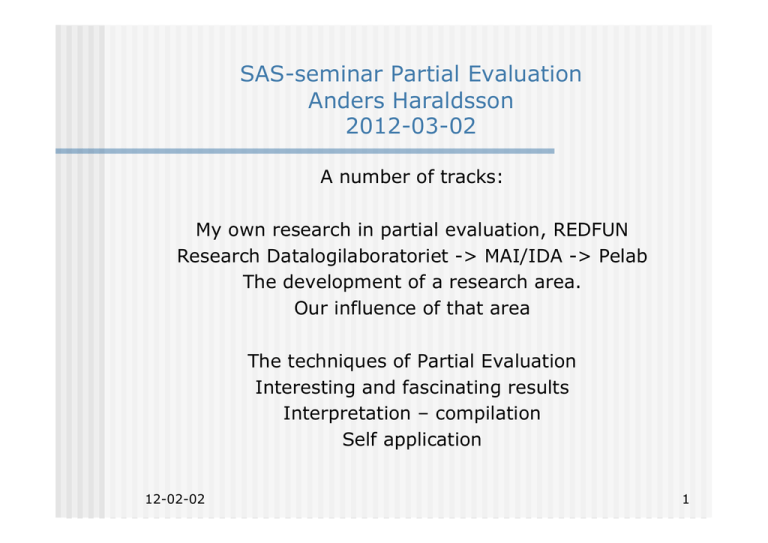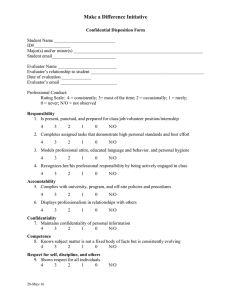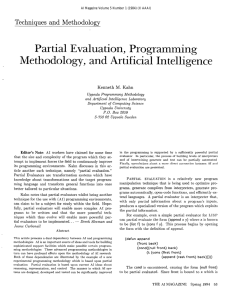SAS-seminar Partial Evaluation Anders Haraldsson 2012-03-02
advertisement

SAS-seminar Partial Evaluation Anders Haraldsson 2012-03-02 A number of tracks: My own research in partial evaluation, REDFUN Research Datalogilaboratoriet -> MAI/IDA -> Pelab The development of a research area. Our influence of that area The techniques of Partial Evaluation Interesting and fascinating results Interpretation – compilation Self application 12-02-02 1 Anders Haraldsson 1966 Start studying Computer Science, Uppsala 1968 Studied last year for Erik Sandewall (Lisp, AI, logik) 1969 Bachelor exam in Uppsala 1969 Started to teach at Umeå, only one semester 1969 We started Datalogilaboratoriet 1970 IBM scholarship 1970 Research PCDB, Partial evaluation 1975 Erik Sandewall appointed professor in CS Most of Datalogilaboratoriet moved to Linköping 1977 Ph D (number 14 LiTH, today 1400) To 1982 Research group with partial evaluation Studierektor, head of department, head of undergraduate 12-02-02 2 Datalogilaboratoriet, Uppsala Univ. 1969-1975 Artificial intelligence (AI), Knowledge representation. Natural language. Programming languages. Data bases. Implementing Lisp systems (IBM/360, Siemens, Fortran) 11 PhD thesis's in Computer Science at MAI/IDA. My own work 1970PCDB Predicate Calculus Data Base. Organization of storing facts. Translating axioms to Lisp-code. “Compiling logic programming (PROLOG) to Lisp” . Continuations. REDFUN. REDuce FUNarg. Partial evaluation. 12-02-02 3 Partial evaluation Simple idea. Kleenes S-m-n theorem 1952 Given f(x, y) = x*y+x Make a specialized version g giving that x=2 g(y) = f(2, y) = 2y+2 A partial evaluator generates that specialized function. PE(f, “x=2) = g More interesting: pow(x,y) = if y=0 then 1 else x*pow(x,y-1) PE(pow,"y=3") = pow-to-3(x) = x*x*x 12-02-02 4 A Partial Evaluator A Partial evaluator evaluates what can be done and leaves the rest of the code. Some call this for mixed computation (Ershov). could handle if a variable had a known value or not constant propagation – calculate constant expressions unfolding (beta-expansion, inline) Replace a call with the body, after substitution of formal parameters against actual ones. pruning conditionals dead code elimination syntax transformations and simplifications …… 12-02-02 5 Partial evaluation REDFUN We did an online Partial Evaluator. Written in Lisp and could partial evaluate Lisp programs. Advantage: No parsing. Lisp code represented as lists, no special AST (Abstract Syntax Tree). Code could be constructed and evaluator with the eval-function. In principle followed the same strategy as an interpreter. Se following outline as a separate slide. 12-02-02 6 Partial evaluation REDFUN The first application. Used it for PCDB. Generated specialized functions for manipulation of facts. Idea: Write few general functions, with a lot of parameters. For every predicate a number of this parameters can be given (arity, one-many-ness, key). Partial evaluate these general functions to a specialized one for each predicate. Axioms were translated to non-deterministic code and there was different skeleton depending on search strategy (backward, forward, deep first breadth first) and then specialized. 12-02-02 7 Partial evaluation REDFUN-2 My thesis work Implement a next generation of REDFUN. Handle a larger language side effects assigments goto-programs Derive more information from the program a variable can have one of a set of values or is of a data type a variable can not have a set values handling of side effects …. …. 12-02-02 8 Partial evaluation REDFUN-2 The environment consisted of value-descriptors ((x . nobin) (y . (:values . (1 2 3))) (z . (:novalues . (4 5 6))) ( z . (:datatype . list-notnil))) if x=2 then …. x has the value 2 …… else …. x can’t be 2 if member(x, (1 3 5)) then … x can be 1, 3 or 5 else …. not 1, 3, 5 if number?(x) then …….. else We have ((y . (:values . (1 2 3))) (x . nobin)) if x=y and member(x, (2 3 4)) then …((x . (:values . (2 3)) (y . (:values . (2 3)))) … else … ((x . nobin) ( y . (:values . ( 1 2 3))) 12-02-02 9 Partial evaluation REDFUN-2 One observation: A lot of examples seem obscure. No one will write such code. Such code may appear when transforming and generating code. And there is of course a lot of information which can not be derived, relations between variables … For that we may need a theorem prover. if x=y then ….. if prime?(x) then if x=7 then ….. 12-02-02 10 Partial evaluation REDFUN-2 En online Partial Evaluator traverse the code as an interpreter and keeps information about variables in the environment. In REDFUN-2: Every expression was partial evaluated in a context, in order to know what kind of information is interested to extract. (if expr …. …) boolean context (and expr …. …. ….) boolean + “true” context (f expr …. ….) value context expr novalue context (as a statement) 12-02-02 11 Partial evaluation REDFUN-2 For every expression, which should remain in the code, was annotated with information. This information was given by semantic functions associated with a function and construction. expression its value (a value-descriptor) if it may perform or depend of a side effect or no variables which may get new values from assignments extracted information if expressions evaluates to true or false 12-02-02 12 Partial evaluation REDFUN-2 Example in Scheme (an obscure one) (if (= x (+ (print 5) (set! y 10)) ) then … else translates to (if (= x (progn (print 5) (set! y 10) 15) ) then … else … print and set! return values. The value of the + expression evaluates. Side effects must remain. The red is evaluated in an Boolean context: it performs or depends on side effects y will be set to 10 if it evaluates to true x will have the value 15 if it evaluates to false x will not have the value 15 12-02-02 13 Partial evaluation Futamuras first projection Relation interpreter – compiler Compiling embedded languages We have an interpreter for a language R. It is written in language L. Interpreter-for-R-written-in-L (program-in-R, environment) Given a fixed program and an PE-for-L PE-for-L (Interpreter-for-R-written in-L, program-in-R) = ? A version of the interpreter specialized for the program = compiled code for program-in-R to L 12-02-02 14 Partial evaluation Futamuras first projection We used this for a number of embedded languages in the INTERLISP system. Pattern matching (regular expressions) Iterative expressions We follow an example for a small pattern match language. IntLispPM (programPM, environment) PELispLisp (IntLispPM , programPM)= programLisp A compilation of a program in pattern-match language to Lisp. We follow an example. 12-02-02 15 Partial evaluation Futamuras second projection But wait a minute. We had: IntLispPM (programPM, environment) PELispLisp (IntLispPM , programPM) = programLisp If ithe first argument (the interpreter) is known, we can partial evaluate the partial evaluator itself? PELispLisp (PELispLisp , IntLispPM) = ? What is the specialized partial evaluator ? A compiler. 12-02-02 16 Partial evaluation Futamuras second projection We got a compiler to compile programs in the pattern match language to Lisp! PELispLisp (PELispLisp , IntLispPM) = CompLispPM->Lisp CompLispPM>Lisp (programPM) = programLisp We call such partial evaluator self-applicable. 12-02-02 17 Partial evaluation Futamuras third projection But wait a minute. We had: PELispLisp (PELispLisp , IntLispPM) = CompLispPM>Lisp If the first arguememt to PELispLisp is known it must be possible to partial evaluate PELispLisp PELispLisp (PELispLisp , PELispLisp ) = ? Is it possible, and what is it ? ? is called cogen (compiler generator). It is an interpreter to compiler generator! 12-02-02 18 Partial evaluation Futamuras third projection We wrote such program for hand, called Redcompile. A bachelor thesis by Lennart Beckman in Uppsala. Used for the PCDB application. Instead of PE(general-PCDB-functions, known-parametervalues) = specializedPCDB-function we did PCOMP(A-general-PCDB-function, “parameters with known parameters”) = A-special-function-for-one-PCDB-function A-special-function-for-one-PCDB-function(known-parametervalues) =specialized-PCDB-function 12-02-02 19 Back to partial evaluation history Futamura described the two first projections in a paper 1970 The third projection was first (in parallel with Turchin) mentioned by us in a paper Beckman & al, A partial evaluator, and its use as a programming tool, in the Artificial Intelligence journal 1976. REDFUN was the first real partial evaluator for a quit large language. The end of 70’s the most prominent researcher in computer science in Soviet Union, Andrei Ershov, worked on mixed-computation and met Sandewall at a conference 1977 in Soviet, where I came in contact with him. I think I made Futamura well-known by sending his paper to Ershov 12-02-02 20 1978. Back to partial evaluation history - IDA At IDA we went on with research and Pär Emanuelson wrote a thesis on using my REDFUN-2 to general pattern matching. He tested our ideas with a much richer pattern match language with conditionals (compare today regular expressions) Jan Komorowski applied the technique to logic programming = partial deduction, and is regarded the pioneer, the first application of partial evaluation to logic programming. Ulf Nilsson had one part of his thesis 1992, where he with partial evaluation mapped Prolog-programs to WAM (Warrens Abstract Machine). 12-02-02 21 Back to partial evaluation history In about 1982 we invited the Danish professor Neil Jones, having a seminar of compiler generation from denotational semantics. We pointed out the other direction with partial evaluation and selfapplication. He took the ideas and after about 2 years he made Futamuras third projection. System called MIX/Similix. Start again from the beginning implementing very simple languages (pure functional Scheme). Then applied to more rich languages (imperative …) and developing more theory. 12-02-02 22 Back to partial evaluation history They introduced a two step PE – offline partial evaluator and introduced BTA – Binding Time Analysis. ‘ Two steps: First an annotation step, analyzing parts if it is static (possible to evaluate) or dynamic. Introduced two version of operations. (define (f (x static) (y dynamic)) (if-s (= x 1) (if-d (= y 2) … …) ….) Next step the optimization step. 12-02-02 23 Back to partial evaluation history In Sweden: Logic programming: Uppsala (Ken Kahn – Pär Emanuelson opponent) SICS (Dan Sahlin) Functional programming, type inference: Chalmers (John HugesJ 12-02-02 24 Back to partial evaluation history Now spread out in the world. Main research at DIKU Copenhagen of Neil Jones and his colleagues. They wrote a book, the PE-bible. I was involved in organizing the first and second Partial evaluation conference and and one editor to a special edition ….. 1987 in Gamle Avernes 1992 in New Haven. The conference today is called PEPM (Partial Evaluation and (Semantics-based) Program Manipulation) 12-02-02 25 Back to partial evaluation history 12-02-02 26 Today PEPM 2012 Philadelphia The PEPM Symposium/Workshop series aims to bring together researchers and practitioners working in the broad area of program transformation, which spans from refactoring, partial evaluation, supercompilation, fusion and other metaprogramming to modeldriven development, program analyses including termination, inductive programming, program generation and applications of machine learning and probabilistic search. PEPM focuses on techniques, supporting theory, tools, and applications of the analysis and manipulation of programs. 12-02-02 28 Today POPL 2012 Philadelphia The annual Symposium on Principles of Programming Languages is a forum for the discussion of all aspects of programming languages and systems, with emphasis on how principles underpin practice. Both theoretical and experimental papers are welcome, on topics ranging from formal frameworks to experience reports. Papers discussing new ideas and areas are most welcome, as are highquality expositions or elucidations of existing concepts that are likely to yield new insights ("pearls"). 12-02-02 29 Looking back on the research More “proof of concept” than theory. Building systems and used it in applications. Very important with our 1976 paper in the AI journal. The main reference paper in the area, during a long time. I (also Komorowski) got a paper at the prestige conference 1978 POPL (Principal Of Programming Languages) and at the first Lisp conference 1980 at Stanford. We could have written more after that. More how to organize a partial evaluator. Methods and algorithms. Why not more journal papers? 12-02-02 30 Compare today with other research areas Can an optimizing compiler do PE today, i.e. the pattern match interpreter. You define that some functions (patmatch and segmatch) should be compiled inline? Is it smart to do all optimization and simplifications as the PE? My REDFUN-2 is mode of less the same as attribute grammars. Inherited and derived attributes. What information can I get from an attribute grammar? What are Fritzson and Broman doing together Magnusson and Herdin in Lund with metacompilation? Mariam Kamkar made a PhD Thesis on slicing. A formal paper 2006 descries the relationships between PE and slicing. Our work was referenced! 12-02-02 31 Today Questions: Is partial evaluation used today? Program transformation on the source level? Is it today an interesting optimization, computers are so fast, why bother of this kind of optimizations?, use general functions. Is it interesting to automate the process to generate compilers? Are there other techniques to use instead? Is it still a hard problem to make really good partial evaluation? Have we obtained optimal code? 12-02-02 32

